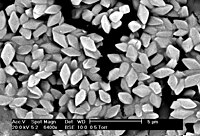
Sampling procedures and action threshold level of vectors of viruses that cause maize lethal necrosis disease in Kenya
Sign Up to like & getrecommendations! Published in 2020 at "International Journal of Tropical Insect Science"
DOI: 10.1007/s42690-020-00150-7
Abstract: Maize lethal necrosis disease (MLND) has emerged as a major threat to maize production in East Africa. The disease is caused by a co-infection of maize by maize chlorotic mottle virus (MCMV) and sugarcane mosaic… read more here.
Keywords: maize lethal; lethal necrosis; corn; disease ... See more keywords

Simultaneous multiplex RT-PCR detection of four viruses associated with maize lethal necrosis disease.
Sign Up to like & getrecommendations! Published in 2021 at "Journal of virological methods"
DOI: 10.1016/j.jviromet.2021.114286
Abstract: Maize lethal necrosis disease (MLND) is a serious disease of worldwide importance. It is caused by the co-infection of maize with maize chlorotic mottle virus (MCMV) and a potyvirus, such as sugarcane mosaic virus (SCMV),… read more here.
Keywords: maize lethal; detection; lethal necrosis; disease ... See more keywords

Using panel community surveys to track the impact of crop pests over time and space - the case of maize lethal necrosis (MLN) disease in Kenya from 2013 to 2018.
Sign Up to like & getrecommendations! Published in 2020 at "Plant disease"
DOI: 10.1094/pdis-08-20-1730-sr
Abstract: Maize lethal necrosis (MLN) disease appeared in Kenya in 2011, causing major damage. In a first survey of 121 communities in 2013, participants estimated the proportion of households affected and the yield loss in affected… read more here.
Keywords: lethal necrosis; loss; maize lethal; disease ... See more keywords

Maize yellow mosaic virus interacts with maize chlorotic mottle virus and sugarcane mosaic virus in mixed infections, but does not cause maize lethal necrosis.
Sign Up to like & getrecommendations! Published in 2021 at "Plant disease"
DOI: 10.1094/pdis-09-20-2088-re
Abstract: A maize-infecting polerovirus, variously named maize yellow dwarf virus RMV2 (MYDV RMV2), MYDV-like, and maize yellow mosaic virus (MaYMV), is frequently found in mixed infections in plants also infected with maize chlorotic mottle virus (MCMV)… read more here.
Keywords: mosaic virus; mixed infections; maize lethal; virus ... See more keywords

Identification of maize lethal necrosis disease causal viruses in maize and suspected alternative hosts through small RNA profiling
Sign Up to like & getrecommendations! Published in 2020 at "Journal of Phytopathology"
DOI: 10.1111/jph.12908
Abstract: Maize lethal necrosis disease (MLND) is a devastating viral disease of maize caused by double infection with Maize chlorotic mottle virus (MCMV) and any one of the Potyviridae family members. Management of MLND requires effective… read more here.
Keywords: maize lethal; lethal necrosis; causal viruses; mlnd ... See more keywords

Maize lethal necrosis viruses and other maize viruses in Rwanda
Sign Up to like & getrecommendations! Published in 2020 at "Plant Pathology"
DOI: 10.1111/ppa.13134
Abstract: Maize lethal necrosis (MLN) is emergent in East Africa, first reported in 2011 in Kenya, and is devastating to maize production in the region. MLN is caused by coinfection of maize with the emergent maize… read more here.
Keywords: maize lethal; lethal necrosis; maize associated; viruses maize ... See more keywords

Maize Lethal Necrosis: An Emerging, Synergistic Viral Disease.
Sign Up to like & getrecommendations! Published in 2018 at "Annual review of virology"
DOI: 10.1146/annurev-virology-092917-043413
Abstract: Maize lethal necrosis (MLN) is a disease of maize caused by coinfection of maize with maize chlorotic mottle virus (MCMV) and one of several viruses from the Potyviridae, such as sugarcane mosaic virus, maize dwarf… read more here.
Keywords: maize lethal; mosaic virus; lethal necrosis; disease maize ... See more keywords

Simulation of Maize Lethal Necrosis (MLN) Damage Using the CERES-Maize Model
Sign Up to like & getrecommendations! Published in 2020 at "Agronomy"
DOI: 10.3390/agronomy10050710
Abstract: Maize lethal necrosis (MLN), maize streak virus (MSV), grey leaf spot (GLS) and turcicum leaf blight (TLB) are among the major diseases affecting maize grain yields in sub-Saharan Africa. Crop models allow researchers to estimate… read more here.
Keywords: maize lethal; lethal necrosis; mln; model ... See more keywords

Fighting Death for Living: Recent Advances in Molecular and Genetic Mechanisms Underlying Maize Lethal Necrosis Disease Resistance
Sign Up to like & getrecommendations! Published in 2022 at "Viruses"
DOI: 10.3390/v14122765
Abstract: Maize Lethal Necrosis (MLN) disease, caused by a synergistic co-infection of maize chlorotic mottle virus (MCMV) and any member of the Potyviridae family, was first reported in EasternAfrica (EA) a decade ago. It is one… read more here.
Keywords: disease resistance; lethal necrosis; maize lethal; disease ... See more keywords